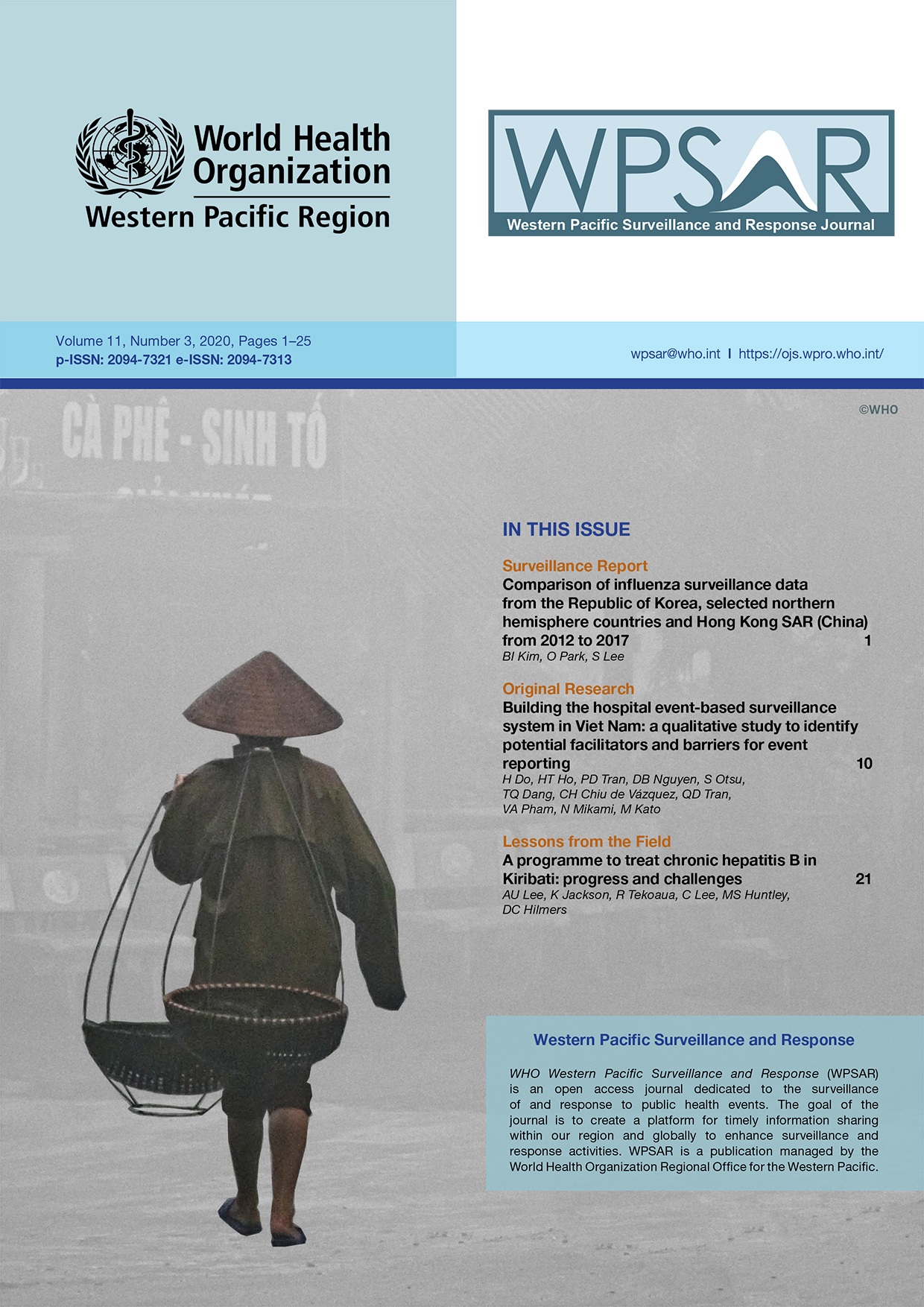Comparison of influenza surveillance data from the Republic of Korea, selected northern hemisphere countries and Hong Kong SAR (China) from 2012 to 2017
DOI:
https://doi.org/10.5365/wpsar.2019.10.2.015Abstract
Influenza surveillance is conducted in many countries; it is one of the most important types of infectious disease surveillance due to the significant impact and burden of the influenza virus. The Republic of Korea has a temperate climate, and influenza activity usually peaks in the winter as in other temperate-climate countries in the northern hemisphere. This descriptive study compared the influenza surveillance data from the Korea Centers for Disease Control and Prevention with that from other countries and areas in the northern hemisphere, namely China, including Hong Kong Special Administrative Region SAR, Japan and the United States of America, to identify seasonal influenza patterns from 2012 to 2017. Data on influenza-like illnesses (ILIs) and laboratory surveillance were collected from various sources; visual comparisons were conducted on the onset, duration and the peak timing of each influenza season based on subtypes. Correlation coefficients were estimated, and time differences for the beginning of influenza seasons between the Republic of Korea and other countries were measured. ILIs in North China and cases reported from Japan’s sentinel surveillance showed high correlations with the Republic of Korea. The number of confirmed influenza cases in Japan showed a high correlation with the laboratory-confirmed influenza cases in the Republic of Korea. We found that there are similarities in the influenza patterns of the Republic of Korea, Japan and North China. Monitoring these neighbouring countries’ data may be useful for understanding influenza patterns in the Republic of Korea. Continuous monitoring and comparison of influenza surveillance data with neighbouring countries is recommended to enhance preparedness against influenza.
References
Killingley B, Nguyen-Van-Tam J. Routes of influenza transmission. Influenza Other Respir Viruses. 2013;7 Suppl 2:42-51.
Suh M, Kang DR, Lee DH, Choi YJ, Tchoe B, Nam CM, et al. Socioeconomic burden of influenza in the Republic of Korea, 2007-2010. PLoS One. 2013;8(12):e84121.
Ortiz JR, Perut M, Dumolard L, Wijesinghe PR, Jorgensen P, Ropero AM, et al. A global review of national influenza immunization policies: Analysis of the 2014 WHO/UNICEF Joint Reporting Form on immunization. Vaccine. 2016;34(45):5400-5.
Finkelman BS, Viboud C, Koelle K, Ferrari MJ, Bharti N, Grenfell BT. Global patterns in seasonal activity of influenza A/H3N2, A/H1N1, and B from 1997 to 2005: viral coexistence and latitudinal gradients. PLoS One. 2007;2(12):e1296.
Lee JS, Shin KC, Na BK, Lee JY, Kang C, Kim JH, et al. Influenza surveillance in Korea: establishment and first results of an epidemiological and virological surveillance scheme. Epidemiol Infect. 2007;135(7):1117-23.
Wagner MM, Tsui FC, Espino JU, Dato VM, Sittig DF, Caruana RA, et al. The emerging science of very early detection of disease outbreaks. J Public Health Manag Pract. 2001;7(6):51-9.
Snacken R, Zucs P, Brown C, Jorgensen P, Mott JA, Amato-Gauci A. Influenza surveillance in Europe. Eur J Public Health. 2011;21(5):674-5.
Schanzer DL, Sevenhuysen C, Winchester B, Mersereau T. Estimating influenza deaths in Canada, 1992-2009. PLoS One. 2013;8(11):e80481.

